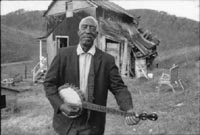Calling Banjo Clark
Despite my commitment to making sure that bluegrass and traditional music remain living, breathing practiced art forms, a fairly strong interest of mine is the history of the music, and understanding the point at which traditional or old-timey music split itself somewhat along racial lines. What went in one direction remained as blues or evolved into versions of gospel and jazz and soul. What went in the other became Monroe’s bluegrass and later country, and somewhere in the middle you had parlor music and ragtime and other forms of popular music. Eventually, we ended up with rock with its own subgenres fusing any and all of the above or more.
But, in the beginning, there was music. And it was good, and it was shared pretty evenly among neighbors regardless of race or creed. Music, like any other language, develops dialects along the way; a single tune can have hundreds of versions, verses, points of view. Ultimately, what started out as a shared musical point of view diverged somewhere along the path tread by Lee and Grant. But until that point, the discourse of social class structure and its relationship to race was an issue that had not been forced, despite the legacy of slavery and its clear social message.
I'm not saying that "message" wasn't there before the Civil War. It was rooted in a perspective that European traditions and education were far superior to the social and cultural norms of African slaves and their descendents, even among our self-aware founding fathers. Even Thomas Jefferson wrote, in referring to the Banjar, that this forerunner of our beloved banjo was "...the instrument proper to them." Despite being so loved for more than 300 years, the banjo was primarily relegated to minstrelsy for the better part of its initial popular run. It wasn't until much later when clawhammer playing was exchanged in bluegrass for the more sophisticated three- and four-finger style playing that it suddenly became regarded as a specialty bluegrass instrument, popularized by mostly white players.
I'm not trying to grind an axe, here, but just find a way of asking, what happened to all the people of color? As the months roll forward and the summer festival season unfolds, stages will be populated with family bands, popular recording artists, and a few well-known legends of old-time. I'm searching for something different, for a change in how we talk about this music, who presents it, who represents it. I want inclusion, the darling of the corporate annual report, but in a real way.  A visit to my newest obsession, the Digital Library of Appalachia, turned up this clip of Clarence Tross b. 1884, interviewed by Roddy Moore. There was a time when not all bluegrass was so neat and tidy and even-metered, let alone, whitewashed.
A visit to my newest obsession, the Digital Library of Appalachia, turned up this clip of Clarence Tross b. 1884, interviewed by Roddy Moore. There was a time when not all bluegrass was so neat and tidy and even-metered, let alone, whitewashed.
http://www.aca-dla.org/FerrumCollege/image/3461.mp3

2 Comments:
Great clip, Mando. As silly as it sounds, I was actually grateful to Ken Burns for doing 'Jazz'. He's a great researcher and dug up SO many old clips and SO much information. And then he presented it in such a way that it made sense. NOW... If we can just get him to do that with bluegrass...
Dear Neuro, I LOVE Ken Burns work. To see him take on this music is a long-term wish of my own. However, I took a well-intentioned, um, "redirectioning" from one bluegrass-loving documentarian who suggested that a Burns-like treatment would be too stodgy. (Visit www.timobrien.net, click on "forum", and check out the thread for the Bluegrass Journey DVD.) The concern is that even a really good documentary would detract from the living/breathing aspect, but I pretty much disagree wholeheartedly. Anyway, evidently there is some good stuff out there but it's not reaching many people and you have to be diligent to find it.
Post a Comment
<< Home